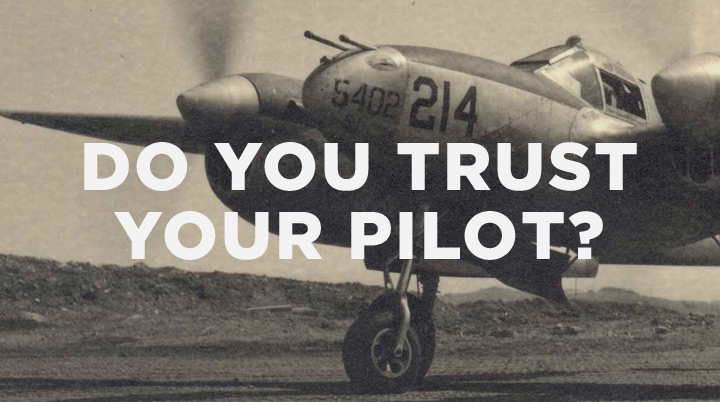Latest
-
Objections to the Christian Faith from the Unchurched and De-Churched
 Tue Dec 02, 2014
Tue Dec 02, 2014
by Resurgence -
Craig Groeschel: We Innovate for Jesus
 Tue Oct 14, 2014
Tue Oct 14, 2014
by Resurgence -
Mark Driscoll: Revelation
 Tue Oct 07, 2014
Tue Oct 07, 2014
by Resurgence -
RESURGENCE LEADERSHIP #034: JOHN PIPER, WHY I TRUST THE SCRIPTURES, PART 2
 Tue Sep 30, 2014
Tue Sep 30, 2014
by Resurgence -
Resurgence Leadership #033: John Piper, Why I Trust the Scriptures, Part 1
 Tue Sep 23, 2014
Tue Sep 23, 2014
by Resurgence

Archives
Do you trust your pilot?

Can you remember a time when you were flying in a plane and it made a sudden turn that made you feel scared, helpless, and wondering if you could trust the pilots to get you to your destination safely? Do you remember feeling out of control, as someone else was in charge and your fate was in their hands?
Working for an organization, including a church or ministry, is kind of like a plane in flight. The senior leaders are up front getting data from private channels and have a perspective out the windshield that no one else has. Most people on the proverbial plane are going about their lives without considering the competency of the pilots' leading, until there is a hard turn and they feel it.
A commercial pilot in our church explained these turns as “bank angles” where one wing stoops down. He said that the response of the passengers directly correlates to the degree of the turn. For example:
- 25–30 degrees: 1.1–1.2 g-force on the body, most people won't feel a thing.
- 45 degrees: 1.5 g-force, people start to feel it.
- 60 degrees: 2-2.5 g-force, people really feel it and start to freak out.
- 70–80 degrees: Around 5 g-force, people start getting tunnel vision as the blood rushes out of their eyes.
Ideally, an organization makes as many 25–30 degree turns as possible. If so, there can be ongoing changes and course corrections without people freaking out and panicking, running through the proverbial cabin. But, sometimes a really hard turn simply has to be made. Those on the plane usually don’t understand why, because they neither have the data nor see the reality that's confronting the pilots flying the plane. Those on the plane have five basic options on how they will respond when the organizational plane makes a hard-banked angle turn:
1. Jump out of the plane
Stand up, freak out, make a scene, grab a parachute, and jump out of the plane with your résumé in hand hoping to land a job somewhere else. If you are really freaked out and negative, you can try and take as many passengers with you as possible, which is in your mind some kind of heroic act.
2. Panic
Just absolutely melt down. Get anxious, sweaty, angry, cry, cause a big fuss, get everyone worked into a frenzy, pretend you know what is going on, stress yourself out, and just fall apart.
3. Storm the cabin
Decide that you know what is really going on and that you are a better pilot, try and get some other passengers to agree with you, form a team, and try to storm the cabin and take over the plane with you as the new captain, saving everyone from the fiery doom you are certain is imminent.
4. Trash the pilots after the plane arrives at its destination safely
Assume the worst, that the pilots are incompetent, uncaring, unloving, drunks, dangerous, thrill seekers, asleep at the wheel, etc. This can be mumbling quietly to those around you, talking loudly to make a scene, confronting the pilots on your way out, cussing someone out at the service desk, writing a nasty letter to headquarters, or posting your critiques online in a flame-throwing exercise.
5. Trust the pilots
Assume that they have way more data and training than you. Assume they see stuff out of their window you don’t see out of yours. Assume they did the right thing, even if you are wearing your drink, your luggage came flying out of the overhead bin, and you need to buy new underwear to replace the ones you were wearing. Just maybe the pilots saved your life and spared you from a less disruptive turn that would have ended in a fiery crash you never saw coming.
It all comes down to trust. If you don’t trust your pilots, then you will jump, panic, storm, or trash.
Who is most likely to trust the pilots? Frequent fliers, those who have been on board long enough to have survived hard banked turns before. And former pilots who have themselves sat in the cockpit of an organization and had to make the same kind of tough decisions.
Who is least likely to trust the pilots? First-time fliers, those who are new to leadership and/or new to the organization and subsequently lack the experience to simply buckle up and ride it out. Also fans of flying who have studied flight and/or visited the cockpit to peer over the pilots' shoulder enought to maintain an illusion that they know how to fly and could do a better job themselves, even though they have no hours in the pilots' chair.
Pray for your pilot(s) and to the Pilot
Yes, a smooth flight is always ideal. But, since the occasional smooth flight remains smooth until the plane explodes into a mountain, some occasional turbulence through uncomfortable and terrifying airspace is a much better option. So, pray for your pilot(s) and to the Pilot whose sovereign hand is ultimately on the wheel.